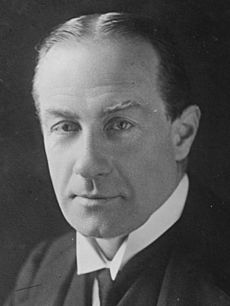National Government (1935–1937) facts for kids
Quick facts for kids National Government |
|
|---|---|
3rd National Government of the United Kingdom |
|
| 1935–1937 | |

Stanley Baldwin
|
|
| Date formed | 7 June 1935 |
| Date dissolved | 28 May 1937 |
| People and organisations | |
| Monarch |
|
| Prime Minister | Stanley Baldwin |
| Total no. of members | 109 appointments |
| Member parties |
|
| Status in legislature | Majority (coalition)
428 / 615 (70%)
|
| Opposition party | Labour Party |
| Opposition leaders |
|
| History | |
| Election(s) | 1935 general election |
| Legislature term(s) |
|
| Predecessor | Second National Government |
| Successor | Fourth National Government |
The National Government of 1935–1937 was a special government in the United Kingdom. It was formed by Stanley Baldwin in June 1935. He became Prime Minister of the United Kingdom after Ramsay MacDonald stepped down.
This government was called a "National Government" because it included members from different political parties. These were the Conservative Party, the Liberal Nationals, and National Labour. Some members did not belong to any party at all. This government was in charge during a very unusual time in 1936. During this year, the UK had three different kings! It also handled the big event known as the Edward VIII abdication crisis. In May 1937, Stanley Baldwin resigned. Neville Chamberlain then took over as Prime Minister.
Contents
What Was the National Government?
A National Government is a type of coalition government. This means that different political parties work together to form the government. They do this instead of just one party being in charge. This often happens during times of national crisis or when no single party wins enough votes.
Why Was This Government Formed?
The National Government was first formed in 1931 during a big economic crisis. It continued into 1935. The idea was that all major parties would work together to solve the country's problems. Stanley Baldwin became Prime Minister in 1935. He continued this type of government.
Key Leaders and Their Roles
Stanley Baldwin was the Prime Minister. He was the main leader of the government. His job was to lead the country and make important decisions. Other important people included:
- Ramsay MacDonald: He was the previous Prime Minister. In this government, he served as the Lord President of the Council. This is a senior role in the government.
- Neville Chamberlain: He was the Chancellor of the Exchequer. This means he was in charge of the country's money and economy. He later became Prime Minister.
- Anthony Eden: He was the Secretary of State for Foreign Affairs. His job was to handle the UK's relationships with other countries.
Important Events: The King Who Left
One of the most famous events during this government was the Edward VIII abdication crisis. This happened in 1936. King George V died, and his son, Edward VIII, became king. However, King Edward VIII wanted to marry an American woman named Wallis Simpson. She had been divorced twice. At that time, it was not acceptable for a British monarch to marry a divorced person.
The government, led by Stanley Baldwin, told the King that he could not marry Wallis Simpson and remain king. After much discussion, King Edward VIII chose to give up his throne. He became the only British monarch to voluntarily abdicate. His younger brother then became King George VI. This event showed how important the government's role was, even in matters concerning the Royal Family.
Who Was in the Cabinet?
The Cabinet is a group of the most important ministers in the government. They meet regularly to make big decisions for the country. Here are the main members of Stanley Baldwin's Cabinet from 1935 to 1937:
Images for kids



